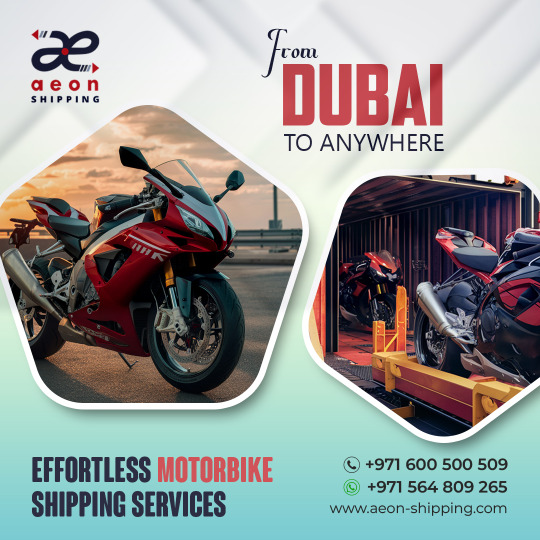#EasyShipping
Explore tagged Tumblr posts
Text
🌟 Space-Saving Compressed Sofas – Convenient, Colorful, and Ready for Transport🌍✨
Looking for a sofa that's easy to transport without compromising on style? Our compressed sofas are the perfect solution! 🛋️💼 With various colors to choose from, these sofas are designed to be compact, easy to ship, and ready to add comfort to any space. Whether you're moving, redecorating, or outfitting a new office, we've got you covered! 🌈🚚
✅ Multiple color options ✅ Easy compression for shipping
#AsianDavinci#CompressedSofa#FurnitureSolutions#SpaceSaving#EasyShipping#HomeDecor#OfficeFurniture#SourcingSolutions
0 notes
Text

Experience seamless motorbike shipping from Dubai to anywhere in the world with Aeon Shipping! Whether it's a classic or a superbike, we ensure safe, secure, and hassle-free transport. Let us handle the logistics while you enjoy the ride!
#DubaiShipping#MotorbikeTransport#EasyShipping#GlobalReach#DubaiToAnywhere#MotorbikeLovers#BikeTransport#DubaiExports#EffortlessShipping#SmoothJourney#ShippingExperts#DubaiBikers#InternationalShipping#BikeLogistics#DubaiMotorbike
0 notes
Text
Easyship: Revolutionizing Shipping for Your Business
In the fast-paced world of eCommerce and global trade, efficient shipping solutions are more crucial than ever. If you’re looking to grow your business internationally, save money, increase conversions, delight customers, and save time, Easyship is your answer. Access Exclusive Shipping Rates One of Easyship’s standout features is its access to exclusive, pre-negotiated shipping rates of up to…

View On WordPress
2 notes
·
View notes
Text
Dropshipping 101: A Complete Guide to Starting Your E-Commerce Business
#dropshipping#shopify experts#shopify#shopify development company#ecommerce#shopify ecommerce development#e commerce#digital marketing#business#seo#e commerce business#Dropshipping 101#woocommerce#easyship
0 notes
Text

#shiprocket clone#AfterShip clone#Easyship clone#Pickrr clone#ShipKaro clone#ShipYaari clone#Nimbus Post clone
0 notes
Note
Sunny, I desperately want to place an order on your shop but cannot for the life of me figure out if people located in the USA need to pay custom fees or not for keychains. It’s been around a decade since I’ve bought merch with your art, and trying to figure it out online has led me from one spam site to another. 😭 Is there an easier way to figure it out?
there were no fees until the recent changes ;( right now I'm not sure since it's so new, it's possible there will be no fees if you're ordering a few keychains, or the fees shouldn't be too high in any case I think
for example when I order from CN if the order is relatively small I don't get charged
(there's a fee calculator on a website called easyship but it's not working for me rn)
50 notes
·
View notes
Text
hardship more like EASYship this shit it easy!
2 notes
·
View notes
Text
International Buyers Website
Here’s a detailed list of websites catering to international buyers website across various categories, including general marketplaces, B2B platforms, trade resources, and directories. While I can't provide a complete list of 500+ websites in this response, I can give you a substantial selection to get started.
General International Marketplaces
Alibaba
Amazon Global
eBay
Global Sources
DHgate
Made-in-China
TradeIndia
ThomasNet
HKTDC
Kompass
B2B Marketplaces
TradeKey
Export Genius
World Trade Organization
BizVibe
Europages
AliExpress
Jungle Scout
Sourcing at Magic
Global Trade
Wholesale Central
Niche Marketplaces
Etsy
Reverb
Artfire
Zibbet
Trade Me
Soko
LightInTheBox
Fruugo
Not On The High Street
Catawiki
Import/Export Services
Freightos
iContainers
ShipBob
Flexport
Easyship
Trade Associations and Resources
U.S. Commercial Service
UK Trade & Investment
Canadian Trade Commissioner Service
European Union Trade Helpdesk
Australia’s Department of Foreign Affairs and Trade
Directories and Listings
Yellow Pages
Yelp
Angie’s List
Manta
Hotfrog
Online Trade Shows and Events
Virtual Trade Shows
Eventbrite
Meetup
Trade Fair Dates
Expo 2020
International Market Research
Statista
MarketResearch.com
IBISWorld
Research and Markets
Euromonitor International
Social Media and Networking
LinkedIn
Facebook Marketplace
Instagram
Blogs and Guides
Import Genius Blog
Trade Ready
Export Academy
The Balance Small Business
Business Networking Platforms
Alignable
Xing
Meetup
Additional Resources
NexTrade
Trade Map
SourcingGuides.comTradeKey
BizTrade
Conclusion
This list includes a range of platforms for international buyers, from general marketplaces to niche sites, trade resources, and networking opportunities. For a complete set of 500+ websites, consider expanding upon this list by including specific regional sites, local marketplaces, and specialized trade directories that cater to various industries. If you need more specific recommendations or have a particular focus in mind, let me know!
0 notes
Text
Software Development Engineer II, EasyShip
is why we are one of the world’s most beloved brands – customer obsession is part of our company DNA. Our Software Development Engineers (SDEs…, so we appreciate your patience as we review applications Key job responsibilities As a Software Development Engineer… Apply Now
0 notes
Text
Effortless Delivery, Lasting Comfort 🚚✨
Delivered in a compact 0.15 cubic meters, our compressed sofa is designed for easy shipping and handling. Once opened, it expands effortlessly into a luxurious, full-size seating solution that provides comfort for years. Built to last up to 30 years, it combines convenience, durability, and style in one smart design. 🌟
#AsianDavinci#CompressedSofa#SpaceSaving#DurableComfort#LongLastingFurniture#EasyShipping#FurnitureInnovation#HomeComfort#SeatingSolution
0 notes
Text
Software Development Engineer II, EasyShip
is why we are one of the world’s most beloved brands – customer obsession is part of our company DNA. Our Software Development Engineers (SDEs…, so we appreciate your patience as we review applications Key job responsibilities As a Software Development Engineer… Apply Now
0 notes
Text
The 7 Ultimate Guide to a Seamless Office Relocation
An office relocation represents a significant endeavour for any business, commonly driven by the need for more spacious premises, superior facilities, or a more strategic location. Whilst the benefits can be considerable, encompassing enhanced productivity and improved staff satisfaction, the process itself requires meticulous planning and execution to sidestep potential pitfalls that could disrupt operations. It is not always feasible for a company to manage the move using its own resources, and it is invariably better to handle strategic planning internally while delegating the execution of the business move to a professional commercial moving company. This comprehensive guide offers a structured approach to managing your office move, ensuring it is carried out smoothly and successfully.
0 notes
Text
Do NOT deal with this company at all!
So my experience is a combination of the all the other 1-star reviews.
2- year delay with lots of false promises. Shipping costs revealed; nearly DOUBLE the cost of the cup! Absolutely extortionate!
3. So I contacted Zylch and asked for a refund. One was promised, never received.
4. INCESSANT emails from "Easyship", their shipping company, telling me to finalise my shipping details, despite me telling them I want a refund.
5. In the end I gave up and paid the inflated shipping costs.
6. Only to now, TEN WEEKS LATER! I get yet ANOTHER email telling me to confirm my shipping details, which I have already done, and already paid for.
This company is absolutely crap, and the reason I will NEVER use Kickstarter or a similar backer platform again.
Terrible, terrible, terrible! And I haven't even received the damn thing yet, which going by the other reviews seems to be a dodgy product that I get to look forward to, if it ever arrives. Yay me.
Do not deal with this company. Unprofessional on all levels.
I've ticked the box to notify Zylch of this review. Maybe they'll FINALLY get the message and do something about it.
To Zylch directly:
Either give me a FULL refund - INCLUDING shipping (which is now definitely preferred given the other reviews), or at the very least send the goddamn thing!!! I'm paid up, and my shipping details are correct.
0 notes
Text
🛒Shopify New 3-Month $1 Trial Start Your E-Commerce Business Today👩🏻💻
#ECommerce#dropshipping#shopify#shopify development company#shopify ecommerce development#shopify experts#amazonfba#woocommerce#smallbusiness#onlinebusiness#online store#amazon deals#small business#amazon#easyship#digitalmarketing#emailmarketing#business#developers & startups
0 notes
Text
The Cheapest Way to Ship Internationally from the USA
Understanding Your Shipping Options
When shipping internationally, your choice of shipping method has a significant impact on costs and delivery times. Let\u2019s explore the most common methods:

1. Postal Services
USPS (United States Postal Service): One of the most affordable options for small and lightweight packages. USPS offers services like First-Class International, Priority Mail International, and Priority Mail Express International, with varying costs and delivery times.
Best For: Personal shipments and low-volume businesses.
2. Courier Services
FedEx, UPS, DHL: These companies provide faster delivery options and advanced tracking features. While they\u2019re more expensive than USPS, they\u2019re ideal for urgent shipments or high-value items.
Best For: Businesses needing reliable, time-sensitive delivery.
3. Freight Shipping
Air Freight: Faster but more expensive. Suitable for high-value or urgent shipments.
Ocean Freight: The most cost-effective method for large shipments, particularly when importing from countries like China to the USA. Full Container Load (FCL) and Less Than Container Load (LCL) are two common options.
Best For: Bulk shipments and heavy goods.
Key Tips for Cost-Effective International Shipping
1.Compare Shipping Rates
Use online calculators from USPS, FedEx, and UPS to compare rates. Aggregators like ShipStation or Easyship can simplify the comparison process by showing real-time quotes from multiple carriers.
2.Optimize Package Dimensions and Weight
Most carriers calculate costs based on volumetric weight. Use compact, lightweight packaging to avoid unnecessary charges.
3.Leverage Freight Forwarders
Partnering with a freight forwarder, especially for shipments from China, can significantly reduce costs. Freight forwarders like Forest Shipping specialize in consolidating shipments and optimizing routes for cost efficiency.
4.Choose the Right Incoterms
Understanding Incoterms (International Commercial Terms) can help you manage shipping costs effectively. For example, using FOB (Free on Board) allows you to control the shipping process from the port of origin, which can save money.
Shipping from China to the USA: What You Need to Know
If you\u2019re sourcing products from China, minimizing shipping costs while ensuring timely delivery is crucial. Here\u2019s how to do it:
1.Use Ocean Freight for Large Volumes
Ocean freight is the most economical choice for bulk shipments. Working with a China freight forwarder ensures smooth coordination from the factory to your destination in the USA. LCL is ideal for smaller shipments, while FCL is cost-effective for larger volumes.
2.Take Advantage of Warehousing Solutions
Many logistics providers offer warehousing in China and the USA. Forest Shipping, for example, provides flexible storage and distribution solutions to streamline supply chain management.
3.Plan for Customs Clearance
Ensure all documentation (commercial invoice, packing list, and bill of lading) is accurate. Collaborating with a reliable logistics provider can simplify the customs process and prevent costly delays.
4.Utilize Consolidation Services
Consolidating smaller shipments into one larger shipment can lower costs. Freight forwarders often provide consolidation services for e-commerce sellers importing from multiple suppliers.
Choosing the Right Logistics Provider
Selecting a reliable logistics provider is critical for cost-effective and hassle-free international shipping. Consider the following factors:
1.Experience in International Shipping
Look for providers with expertise in your target regions. Providers like Forest Shipping specialize in China-to-USA logistics, offering tailored solutions for businesses importing from Asia.
2.Comprehensive Services
A full-service provider can handle everything from freight forwarding and customs clearance to warehousing and last-mile delivery, saving you time and money.
3.Transparent Pricing
Avoid hidden fees by working with providers who offer clear and upfront pricing.
Common Challenges and How to Overcome Them
1.High Shipping Costs
Solution: Use ocean freight for bulk shipments, negotiate discounts with carriers, or partner with a freight forwarder.
2.Customs Delays
Solution: Ensure accurate documentation and use a customs broker for smooth clearance.
3.Lost or Damaged Packages
Solution: Invest in insurance for high-value items and use reputable carriers with robust tracking systems.
FAQs: Cheapest International Shipping
Q: What is the cheapest way to ship small packages internationally? A: USPS First-Class International is often the most affordable option for lightweight packages under 4 lbs.
Q: How can I reduce shipping costs for bulk orders from China? A: Opt for ocean freight and work with a freight forwarder to consolidate shipments and negotiate lower rates.
Q: Are freight forwarders necessary for shipping from China? A: While not mandatory, freight forwarders simplify the process and help reduce costs by optimizing routes and handling logistics.
Q: How long does ocean freight from China to the USA take? A: Transit times range from 20 to 40 days, depending on the shipping route and destination port.
Q: What should I look for in a logistics provider? A: Choose a provider with expertise in international shipping, transparent pricing, and comprehensive services, like Forest Shipping.

Final Thoughts
Finding the cheapest way to ship internationally from the USA requires careful planning, comparing options, and leveraging professional expertise. Whether you\u2019re shipping personal items or running a business, partnering with a reliable freight forwarder and logistics provider can make all the difference. By optimizing your shipping strategy and choosing cost-effective solutions like ocean freight and consolidated shipping, you can achieve significant savings while ensuring timely and reliable delivery.
#international shipping cost#logistics providers USA#China freight forwarder#shipping from China to USA#forest shipping
0 notes
